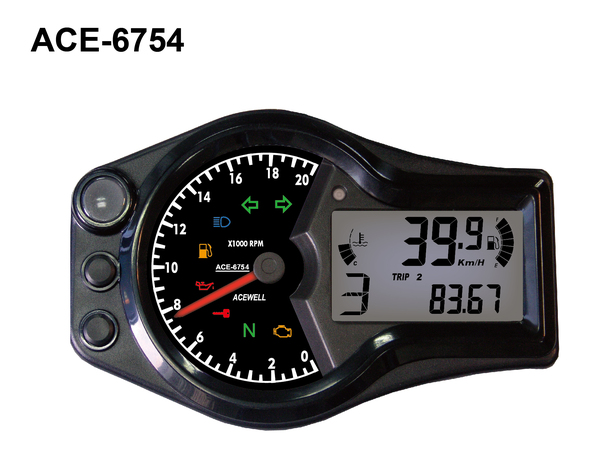The Relevance of a Tachometer in Keeping Track Of Engine Rate and Efficiency in Automotive Applications
In the realm of auto engineering, the tachometer stands as an essential instrument in the chauffeur's toolbox, offering a direct home window right into the inner operations of a lorry's engine. Beyond its feature as a mere scale of transformations per min (RPM), the tachometer acts as an important tool for enthusiasts and specialists alike, providing real-time understandings into engine efficiency and health and wellness. Understanding the significance of this gadget exceeds surface-level monitorings, delving right into the complex relationship in between engine speed, power outcome, and general driving experience. As we explore the complex function of the tachometer in vehicle applications, a deeper gratitude for its influence on lorry dynamics and performance begins to emerge.
Significance of Checking Engine RPM
Keeping track of engine RPM, or transformations per min, is a crucial aspect of vehicle upkeep and efficiency evaluation. Engine RPM straight associates with the rate at which the engine's crankshaft rotates, indicating how quickly the engine is running.
Additionally, checking engine RPM is vital for performance evaluation in racing and high-performance automobiles. Keeping ideal RPM degrees is essential for attaining peak power outcome and acceleration. Racers frequently make use of tachometers to guarantee they are operating within the excellent RPM variety for optimum efficiency. In summary, monitoring engine RPM is not just important for detecting problems however additionally for optimizing engine efficiency in different vehicle applications.

Advantages of Real-Time Data
In automotive applications, real-time information plays a vital role in offering instantaneous insights into the efficiency and problem of the car. By continuously keeping track of different criteria such as engine speed, temperature level, fuel intake, and extra, real-time data supplies numerous benefits that add to boosted performance and security on the roadway.
One significant advantage of real-time data is its capability to alert drivers and service technicians to any type of abnormalities or concerns promptly. This aggressive technique allows fast recognition of possible issues, allowing for prompt treatments to avoid further damages or break downs. Furthermore, real-time data facilitates efficiency optimization by providing prompt comments on driving routines and engine effectiveness. Motorists can change their actions in real-time based upon this details to attain much better fuel economic climate and lengthen the life expectancy of their vehicle.

Moreover, real-time data plays an essential function in modern-day automobile diagnostics, making it possible for specialists to quickly identify and resolve malfunctions. This causes lowered downtime, reduced maintenance prices, and inevitably, boosted overall automobile reliability and durability (tachometer). By using the power of real-time information, automotive stakeholders can make educated choices that positively impact both the performance and long life of the automobile
Influence On Gear Shifts
The tachometer plays a crucial basics duty in enhancing gear changes by offering real-time engine rate information to the driver. When approaching the redline on the tachometer, it indicates the motorist to upshift to prevent over-revving the engine and triggering possible damages.
Additionally, the tachometer aids in accomplishing smoother equipment shifts, especially in hand-operated transmissions. By keeping an eye on engine speed, drivers can implement equipment shifts at the optimal RPM variety, reducing jerking movements and decreasing wear on the transmission components. This accuracy in equipment modifications not just boosts driving comfort but likewise adds to sustain effectiveness.
Enhancing Gas Performance
Provided the essential role the tachometer plays in optimizing gear shifts for efficiency and engine health and wellness, it directly adds to taking full advantage of gas efficiency in auto applications. By offering real-time responses on engine rate, the tachometer helps drivers in preserving one of the most reliable RPM variety for fuel economy. When chauffeurs constantly monitor the tachometer and change their driving habits as necessary, they can prevent unnecessary fuel consumption triggered by over-revving or carrying the engine.
Moreover, the tachometer aids drivers determine one of the most fuel-efficient equipment to be in at any kind of given moment, stopping the engine from working harder than required. This is particularly critical throughout velocity and travelling, where remaining in the appropriate equipment can considerably impact fuel efficiency. Additionally, the tachometer can alert vehicle drivers to potential mechanical concerns that Bonuses could be negatively influencing fuel economic situation, such as a slipping clutch or a blocked air filter. In final thought, the tachometer functions as a beneficial tool in enhancing gas effectiveness by promoting optimum driving habits and identifying locations for improvement in the vehicle's efficiency.

Making Best Use Of Engine Longevity
The tachometer's role in monitoring engine speed and efficiency contributes in guaranteeing the long life of vehicle engines. By using the tachometer efficiently, drivers can optimize engine durability through conscious RPM monitoring. Constantly revving an engine as well high can cause extreme deterioration on vital elements, such as the pistons, shutoffs, and bearings. Gradually, this can result in decreased engine performance and potential malfunctions. Monitoring the tachometer permits chauffeurs to stay within the recommended RPM range for their lorry, preventing unneeded strain on the engine and expanding its lifespan.

Conclusion
In verdict, the tachometer plays a crucial function in monitoring engine rate and performance in vehicle applications. By offering real-time information on RPM, it enables for reliable gear changes, enhanced fuel performance, and made best use of engine longevity. This device is important for keeping optimal engine performance and making certain the overall performance of a vehicle.